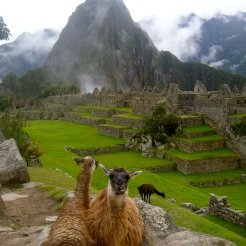We woke up at 4:00am so we could reach Machu Picchu in time for sunrise. Edwin, our cook, stayed behind to cook us one last meal. Fresh pancakes and maple syrup. After gobbling down as much as we could, we gathered on the side of the street to hitch a bus ride up to the Sanctuary’s entrance.
We hopped on the bus as the twilight blue dawn of morning began lifting her veil. The higher up we climbed, everything turned white. By the time we reached the top, the sun slowly peaked through behind the rugged mountain tops, leaving us tucked in natures grace amongst the clouds.
After acquiring tickets to climb Huayna Picchu, and waiting in an awful line where one of my group members had his camera stolen, we began our tour of Machu Picchu.
Meaning “Old Peak”, the pre-Columbian 15th century site situated at 2,430 metres (7,970 ft), sits on a mountain ridge overlooking the Urubamba Valley. Archaeologists believe it was the estate of the Incan Emperor Pachacuti (1438-1472) , where building began around 1400 and was abandoned around the time of the Spanish conquest. Nothing is for certain as the Spanish never saw these peaks, and the Inca’s didn’t write anything down. What remains is a glimpse of man’s astonishing capabilities to build a civilization to exist in perfect harmony with the surrounding nature.
The Sun temple was built on a rock that is illuminated on the summer solstice (my birthday). The Water Temple nearby boasted a fountain, still circulating fresh water from Incan built water channels, and the Temple of the Condor had a hidden path and stairwell through a colossal rock that leads one to the top of a throne with ceremonial niches encircling the magnificent view of the mountains.
Hiram Bingham’s team found over a hundred human skeletons (some mummified) of men, women, and children. It’s remote and grand location in the middle of a sacred valley, and the number of religious constructions highly suggest this place held spiritual significance and was an incredible exertion of power.
The highest point of the complex has two astonishing structures. The first being a compass carved out of the mountain, that points to the 4 cardinal directions. Following a large and steep staircase, we are taken to the “Astrological Tower” where exists a Sun Dial in near perfect condition( During the Spanish Conquest, all Sun Dials were destroyed), whose top points towards the four sacred peaks in the valley which was also pointing towards the four cardinal directions.
There were rocks that were in the shape of the sacred peaks that are in background. One was said to be a Sacred Rock, when touched one can feel the energy of the mountain. (Yes, I touched it and yes I felt something, but again, I was feeling the energy everywhere.)
Machu Picchu was built on top of an intricately designed drainage system, that not only brought fresh water into the city, but also drained water out, thus preventing the threat of collapse from torrential rains. Archaeologists found over 100 of these channels situated throughout the complex further confirming the engineering genius of the Incas.
Archaeologists figure that in order to have made it to the top, the Incas began their building from the bottom. Recent excavations further down below the main sites and terraces of the complex, have led to the discovery of even more terraces and caves tombs.
There is a good idea of what was being built, but its purpose is not for certain. What is for certain, is that the building stopped abruptly. Whether it was because of the spread of small pox that occurred, or the Incan civil war which both crippled the civilizations strength, and then the final destruction by the Spanish, this is something we will never know.
We climbed to the top of Huayna Picchu, which is not for those scared of heights. Once at the top though, the fear subsides and the surrounding splendours of nature took its place. The climb down was worse than the climb up. It was everything all over again, only this time looking down.
When I finally made it back to the main complex, I immersed myself in every possible structure I could make my way to. Imagining what this place was before Bingham’s discovery, and what it looked like when he walked through it for the first time almost 100 years ago, completely overtaken by wild vegetation… What was this place before Bingham’s discovery…?
I was stunned by the sublime views of sacred peaks following me everywhere I walked.
Sanctuary.
Copyright © R.R.Rowing Through Life. You may copy and redistribute this material so long as you do not alter it in any way and the content remains complete, credit is given to the author, and you include the following link at the top of the article: http://www.rowingthroughlife.wordpress.com






















